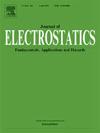利用电流波形测量研究人体静电放电的感觉阈值
IF 2.1
4区 工程技术
Q3 ENGINEERING, ELECTRICAL & ELECTRONIC
引用次数: 0
摘要
人类感知阈值常被用来突出静电放电(ESD)敏感器件的脆弱性。然而,对人体感知ESD阈值的研究是有限的,并且在电子工业中电压阈值经常被夸大。新出现的证据表明,个体可能在较低的电压下检测到ESD,而不是在非同行评审的来源中引用的电压。众所周知,标准测试方法不能准确反映真实的人体金属放电或人体放电情况。每个放电事件都是独一无二的。为了解决这个问题,我们记录和分析了11名医疗保健参与者的130多个放电电流波形,以1 Ω电流目标进行测量,以更好地了解真实人体ESD事件的特征。假设ESD的感知和感应不仅取决于电压和电容等源参数,还取决于产生的电流波形的特性。为了研究这一点,将每个ESD感知实例与相应的电流波形联系起来。研究了重复放电事件的统计不确定性,并给出了全放电波形变化的例子。详细概述了测试方法,以支持潜在的未来研究。本文章由计算机程序翻译,如有差异,请以英文原文为准。
Investigating the human sensory threshold for electrostatic discharge using current waveform measurements
Human perception thresholds are often used to highlight vulnerabilities of electrostatic discharge (ESD) sensitive devices. However, research on human sensory thresholds for ESD is limited, and voltage thresholds are frequently overstated within the electronics industry. Emerging evidence suggests that individuals may detect ESD at lower voltages than those cited in non-peer-reviewed sources. It is well established that standard test methods, do not accurately reflect real-world human metal discharge or human body discharge scenarios. Each discharge event can be considered unique. To address this issue, we recorded and analysed over 130 discharge current waveforms, measured with a 1 Ω current target, from eleven healthcare participants to better understand the characteristics of real human ESD events. It is assumed that the perception and sensing of ESD depend not only on source parameters such as voltage and capacitance but also on the characteristics of the resulting current waveform. To investigate this, each instance of ESD perception was linked to the corresponding current waveform. The statistical uncertainty of repeated ESD events was examined, and examples of variations in full discharge waveforms are presented. The test methodology is outlined in detail to support potential future research.
求助全文
通过发布文献求助,成功后即可免费获取论文全文。
去求助
来源期刊

Journal of Electrostatics
工程技术-工程:电子与电气
CiteScore
4.00
自引率
11.10%
发文量
81
审稿时长
49 days
期刊介绍:
The Journal of Electrostatics is the leading forum for publishing research findings that advance knowledge in the field of electrostatics. We invite submissions in the following areas:
Electrostatic charge separation processes.
Electrostatic manipulation of particles, droplets, and biological cells.
Electrostatically driven or controlled fluid flow.
Electrostatics in the gas phase.
 求助内容:
求助内容: 应助结果提醒方式:
应助结果提醒方式:


